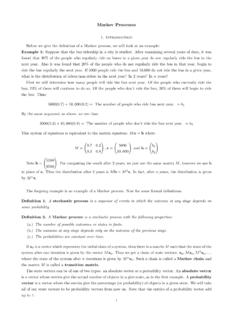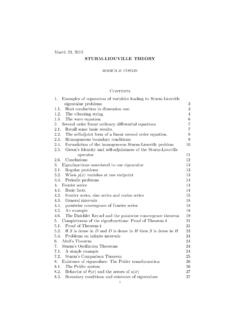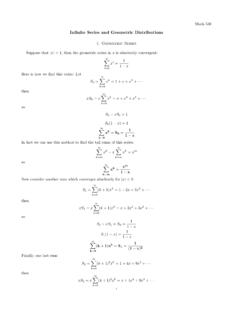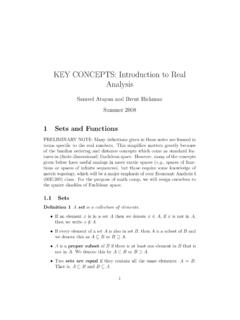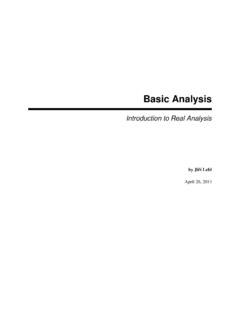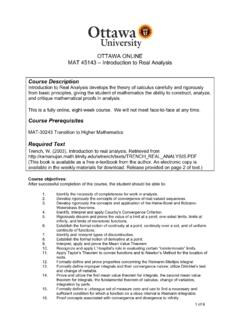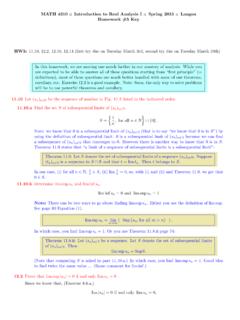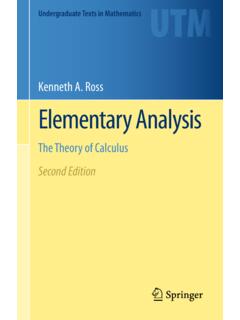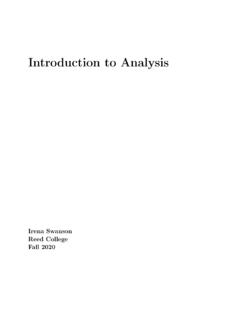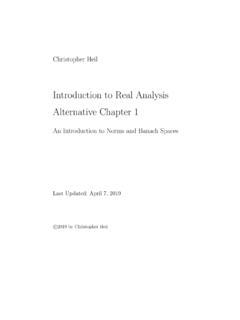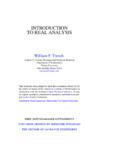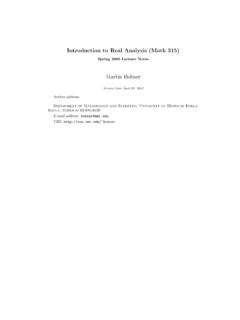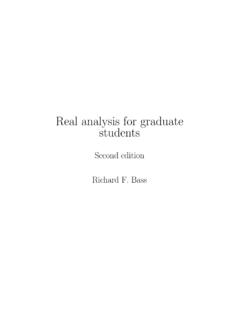Transcription of Basic Analysis: Introduction to Real Analysis
1 Basic AnalysisIntroduction to real Analysiswith University of Pittsburgh supplementsFall 2011by Ji r LeblJuly 30, 20112 Typeset in 2009 2011 Ji r LeblPitt additions Copyrightc 2011 Frank Beatrous and Yibiao PanThis work is licensed under the Creative Commons Attribution-Noncommercial-Share Alike States License. To view a copy of this license, nc- send a letter to Creative Commons, 171 Second Street, Suite300, San Francisco, California, 94105, can use, print, duplicate, share these notes as much as you want. You can base your own noteson these and reuse parts if you keep the license the same.
2 If you plan to use these commercially (sellthem for more than just duplicating cost), then you need to contact me and we will work somethingout. If you are printing a course pack for your students, then it is fine if the duplication service ischarging a fee for printing and selling the printed copy. I consider that duplicating the writing of these notes, the author was in part supported by NSF grant more information (including contact information).ContentsPitt about these notes .. Analysis .. set theory .. exercises .. 221 real properties .. set of real numbers.
3 Value .. and the size ofR.. representation of real numbers .. exercises .. 432 Sequences and and limits .. about limits of sequences .. superior, limit inferior, and Bolzano-Weierstrass .. sequences .. numbere.. topics on series .. exercises .. 933 Continuous of functions .. functions .. and intermediate value theorems .. continuity .. of inverse functions .. exercises .. 1214 The derivative .. Inverse Function Theorem .. value theorem .. s theorem .. exercises.
4 1415 The Riemann Riemann integral .. of the integral .. theorem of calculus .. : logs and exponentials .. exercises .. 1736 Sequences of and uniform convergence .. of limits .. topics on Uniform Convergence .. s theorem .. exercises .. 199A Propositions .. Quantifiers .. Negating a Proposition .. Proofs .. 206 Further Reading209 Index211 Pitt PrefaceThis is a slightly modified version of a free real Analysis textbook by Ji r Lebl. Modifications consistof a small amount of additional material to make the book more suitable for use in the introductoryanalysis sequence at the University of Pittsburgh.
5 Specific material added to this version is Section on decimal representations of real numbers; Section on irrationality of the numbere; Section with some additional topics on series; Section on continuity of inverse functions; Section on differentiation of inverse functions; Section on logarithms and exponentials; Section with additional material on uniform convergence; Appendix on logic an proof; Additional exercises at the end of each in the Pitt Mathematics Department thank Professor Lebl for making this material availablean no cost, along with the LATEX source code which allowed us to customize the book for our Notes about these notesThis book is a one semester course in Basic Analysis .
6 These were my lecture notes for teaching Math444 at the University of Illinois at Urbana-Champaign (UIUC) in Fall semester 2009. The course isa first course in mathematical Analysis aimed at students who do not necessarily wish to continue agraduate study in mathematics. A prerequisite for the course is a Basic proof course, for exampleone using the (unfortunately rather pricey) book [DW]. The course does not cover topics such asmetric spaces, which a more advanced course would. It should be possible to use these notes for abeginning of a more advanced course, but further material should be book normally used for the class at UIUC is Bartle and Sherbert, Introduction to RealAnalysisthird edition [BS].
7 The structure of the notes mostly follows the syllabus of UIUC Math 444and therefore has some similarities with [BS]. Some topics covered in [BS] are covered in slightlydifferent order, some topics differ substantially from [BS] and some topics are not covered at example, we will define the Riemann integral using Darboux sums and not tagged Darboux approach is far more appropriate for a course of this level. In my view, [BS] seemsto be targeting a different audience than this course, and that is the reason for writing this presentbook. The generalized Riemann integral is not covered at the integral is treated more lightly, we can spend some extra time on the interchange of limitsand in particular on a section on Picard s theorem on the existence and uniqueness of solutions ofordinary differential equations if time allows.
8 This theorem is a wonderful example that uses manyresults proved in the excellent books exist. My favorite is without doubt Rudin s excellentPrinciples ofMathematical Analysis [R2] or as it is commonly and lovingly calledbaby Rudin(to distinguishit from his other great Analysis textbook). I have taken a lot of inspiration and ideas from , Rudin is a bit more advanced and ambitious than this present course. For those thatwish to continue mathematics, Rudin is a fine investment. An inexpensive alternative to Rudin isRosenlicht sIntroduction to Analysis [R1]. Rosenlicht may not be as dry as Rudin for those juststarting out in mathematics.
9 There is also the freely downloadableIntroduction to real AnalysisbyWilliam Trench [T] for those that do not wish to invest much want to mention a note about the style of some of the proofs. Many proofs that are traditionallydone by contradiction, I prefer to do by a direct proof or at least by a contrapositive. While the78 Introduction book does include proofs by contradiction, I only do so when the contrapositive statement seemedtoo awkward, or when the contradiction follows rather quickly. In my opinion, contradiction ismore likely to get the beginning student into trouble. In a contradiction proof, we are arguing aboutobjects that do not exist.
10 In a direct proof or a contrapositive proof one can be guided by intuition,but in a contradiction proof, intuition usually leads us also try to avoid unnecessary formalism where it is unhelpful. Furthermore, the proofs and thelanguage get slightly less formal as we progress through the book, as more and more details are leftout to avoid a general rule, I will use:=instead of=to define an object rather than to simply showequality. I use this symbol rather more liberally than is usual. I may use it even when the context is local, that is, I may simply define a functionf(x):=x2for a single exercise or you are teaching (or being taught) with [BS], here is the correspondence of the sections.
